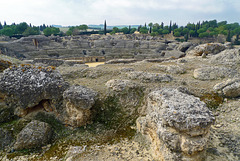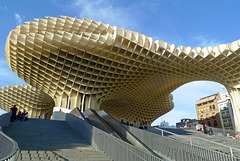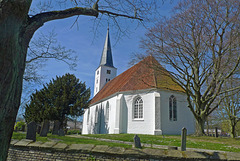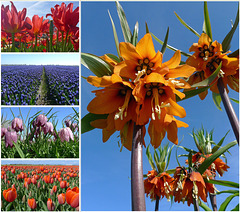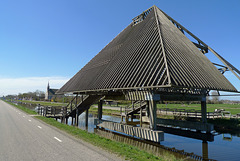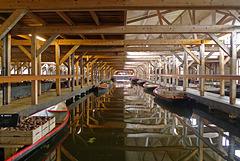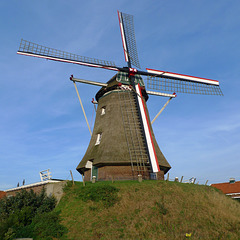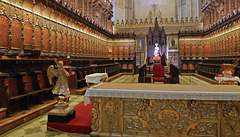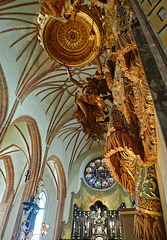Jaap van 't Veen's photos
Spain - Santiponce, Italica
| |
|
|
|
The city of Italica - just outside the town of Santiponce and less than 10 km’s northwest of Sevilla - was founded in 206 BC by the Roman general Scipio in order to settle Roman soldiers, who were wounded in the Battle of Ilipa.
Italica was one of the earliest Roman settlements in Spain and was the birthplace of two emperors: Trajan and his adopted son Hadrian (from the wall across England).
Italica is divided into two areas: ‘Vetus Urbs’ (old city), which lies under the centre of Santiponce, and ‘Nova Urbs (new city), created by Hadrian as an extension of the existing town. Hadrian added temples, and rebuilt public buildings. Italica’s amphitheater seated 25,000 spectators and was the third largest in the Roman Empire. The city's population at the time is estimated to have been only 8000.
The excavation of Italica began mid 18th century and still continues. Following extensive excavations and the building of visitor facilities, Italica is now a popular destination for tourists, offering the amphitheater and remains of the city with paved roads and some stunning floor mosaics.
Sweden - Sigtuna, Rådhus
| |
|
|
|
Sigtuna is Sweden’s oldest medieval city. The main street with many coloured wooden houses brings one to the ‘Stora Torget’ with the (former) city hall. Without any doubt this ‘Rådhus’ is one of the nicest buildings of the town. It is considered being the smallest city hall in Europe with just two rooms. One of them was used by the city council, the other was the ‘police station’ and had two cells for prisoners.
In 1737 the old town hall was in a state of disrepair and the mayor decided to build a new one. The inhabitants of Sigtuna brought together the funds for the construction and in the year of 1744 the new town hall was inaugurated.
Today, the ‘Rådhus’ is part of the Sigtuna Museum.
Spain - Sevilla, Metropol Parasol
| |
|
|
|
Metropol Parasol is a wooden structure, designed by the German architect Jürgen Mayer-Hermann and was completed in April 2011. The innovative structure is made from bonded timber with a polyurethane coating.
With its dimensions of 150 by 70 metres and a height of 26 metres it is considered being the largest timber-framed structure in the world. The Metropol Parasol is popularly known as ‘Las Setas’ (the Mushrooms).
The structure consists of six parasols in the form of giant mushrooms. The panoramic terraces and a short rooftop promenade offer visitors one of the best views of Sevilla.
Sweden - Sigtuna, Mariakyrkan
| |
|
|
|
The construction of the ‘Mariakyrkan’ (St. Mary’s Church) started in the year of 1230 and was inaugurated in 1247. It is the oldest stone building in the area around Lake Mälaren. The church was built even before Stockholm was founded. The beautiful brick exterior shows a style between Romanesque and Gothic.
The church originally belonged to a Dominican monastery, but was demolished after the Reformation in 1530 and the Mariakyrkan became the local parish church. The church is the only medieval church in Sigtuna to have survived the Reformation.
The interior houses a number of fine medieval artifacts and wall paintings. The altarpiece has sculpted figures of the 14th century (PiP 1) and beneath the beautiful stained-glass window is a magnificent altarpiece, which probably was made in Sigtuna (PiP 2).
Nederland - Heiloo, Witte Kerk
| |
|
|
|
Heiloo – originally named ‘Heilegelo’ (= ‘holy woods’) - dates back to the early 8th century and grew around a church which most probably was founded by missionary St. Willibrord around 700. A well next to the church still bears the name of Willibrord.
In the 15th century the church was extended. The building burnt down in 1568, was rebuilt, but five years later met a similar fate during the siege of the city of Alkmaar.
The present church was rebuilt in 1630. This former reformed church - no longer used for regular services- is a one-aisled building. The tower and part of the walls of the nave are in Romanesque style, while transept and choir are Gothic. The White Church has two organs; the large organ is composed in 1966 of pipes from an organ (1740), which came from a Roman Catholic hidden church in Alkmaar (PiP).
Early 19th century it became its striking white colour and since that time it was named ‘White Church’. Between 1964 and 1966 the church became a last restoration and its present appearance.
Nederland - Noord-Holland, bloeiende bollen
| |
|
|
|
The so called ‘Top of North Holland (Kop van Noord-Holland) offers one of the largest areas of bulb flower fields in the world. During spring (mid April till mid May) tulips, narcissus, hyacinths and other bulbs show their amazing colours in blooming bulb fields.
This bulb growing area developed after World War I around the town of Anna Paulowna and after World War II there was even a huge expansion.
Main picture: Fritillaries imperialis/crown imperial/keizerskroon
Small pictures: tulips, hyachint field, Fritillaria meleagris/snake's head/kievietsbloem, tulip field
PiP: blooming bulbflower fields
Nederland - Sint Maartensbrug, Stolpbrug
| |
|
|
|
Making a bike trip in North Holland, I came across the ‘Stolpbrug’ just outside the village of Sint Maartensbrug. At first glance it didn’t look like a bridge and is located somewhere ‘in the middle of nowhere’ over the ‘Grote Sloot’. The structure is quite unique and can only be used by pedestrians and cyclists.
After some research I found that the ‘Stolpbrug’ is an artwork designed by Joke Zaal. The ‘bridge’ is a monument to mark the 400 years of existence of the ‘Zijpepolder’. The skeleton of the ‘Stolpbrug’ has the shape of a ‘stolpboerderij’ (haubarg), which is typical for this part of the province. Former Queen Beatrix of the Netherlands opened this ‘artwork bridge’ in May 1997.
The ‘bridge’ is made of African azobé wood and has a height of thirteen metres. Except a bridge it is also a platform for cultural events and has a lookout with great views over the flat polders.
Nederland - Heiloo, Nijenburg
| |
|
|
|
Eighteenth-century Nijenburg, located between Alkmaar and Heiloo, is a manor in the woods of Heiloo and surrounded by typical Dutch meadows. Since 1928 the estate is owned by the Dutch nature preservation organisation ’Natuurmonumenten’. Manor and carriage house are transferred to the ‘Vereniging Hendrick de Keyser’.
The estate is located on an elevation of the former shoreline of the North Sea. The surrounding grasslands - due to excavations - are a lot lower.
Nijenburg estate was owned for centuries by the families ‘Van Egmond van de Nijenburg’ and ‘Van Foreest’. In the year of 1705 ‘Gerard van Egmond van de Nijenburg’ built the current manor in the classic Dutch style with plain brick facades, using the remains of an older building on this site.In the 19th century the building became its white plaster. Since then the house has the romantic look of a rural location in the green.
Nederland - Limmen, Hortus Bulborum
| |
|
|
|
The Hortus Bulborum is the only museum garden in the world where you can find an enormous variety of historical tulips, hyacinths, daffodils and other bulbous cultivars, species and varieties in bloom. Every spring the garden transforms into a treasure trove full of dazzling colours, beautiful shapes and overwhelming fragrances.
Hortus Bulborum offers about 2.650 varieties and species of historical tulips; among them the famous ‘Duc van Tol Red and Yellow’ (PiP 1); the eldest known cultivar from 1595. More info and pictures of the 'Duc van Tol' tulip: www.ipernity.com/doc/294067/48532884
Apart from tulips over 1.100 different varieties and species of daffodils can be admired, as well as more than 100 varieties of both crocuses and hyacinths (PiP 2) and 25 of the Fritillaries imperialis (PiP 3).
The aim of Hortus Bulborum is to maintain these cultivars and safeguard them for the future generations.
Spain - Sevilla, Iglesia del Salvador
| |
|
|
|
Iglesia del Salvador (Salvador Church) is built on the remains of the 9th century Ibn Adabbas Mosque, the main mosque of Sevilla. When Christians conquered Seville, they allowed initially use as a mosque, but in 1340 it was converted into the parish church of Salvador, which lasted till 1671, when the building was quite deteriorated.
Construction of the present church started in 1674 and was fished in 1712. It has a basic structure with three naves and is the second largest church of Sevilla, after the cathedral.
The main altarpiece (PiP) from late 18th century is an absolute highlight in the exuberant interior of the church; it is considered to be one of the most monumental and representative works of the baroque style in Sevilla.
The plaza in front of the church, Plaza del Salvador, provides a popular meeting place and destination for both locals and visitors.
Sweden - Märsta, Steninge Slott
| |
|
|
|
The history of Steninge began at the end of the 13th century when the first known settlement was established in this area. In 1667, Carl Gyllenstierna inherited the Steninge estate. His relationship with the queen allowed him to develop the estate and the beautiful areas around Lake Mälaren. In 1680 the well known architect Nicodemus Tessin the Younger was asked to design a palace. He was inspired by the French and Italian baroque style.. In 1705 Steninge Slott (Steninge Palace or Steninge Manor) was completed, overlooking Swedish largest lake.
Several buildings are dotted around the palace, in particular a huge stone barn dating from the end of the 19th century (PiP2), now housing several shops, an art gallery and a restaurant. Nowadays Steninge Slott is privately owned by a company and used for cultural events.
Steninge Slott, is considered being “Sweden’s most beautiful and perfect baroque building”. I have to say that from a distances it looks quite good, but coming closer it was obvious that the manor could use some serious maintenance (PiP 1).
Nederland - Broek op Langedijk, Broeker Veiling
| |
|
|
|
The ‘Broeker Veiling’ (Broeker Auction) is a Dutch national monument dating back to the year of 1912, when the beautiful auction room (PiP2) was built with details in Jugendstile-style. The impressive mooring halls were added in 1925. The complete wooden structure is built on 1900 wooden piles above the water.
These mooring halls protected waiting boats with vegetables (PiP1) for rain and sunshine.
This oldest sail-through auction in the world was used till 1973; nowadays it is a museum. You also can take part as a real trader in the auction room.
Spain - Sevilla, Plaza de España
| |
|
|
|
Plaza de España is located in the Parque de María Luisa. It is one of the architectural landmarks of Sevilla. The semi-circular building was built for the Ibero-American Exposition of 1929 and was the central office. Architect Aníbal González mixed a style inspired by the renaissance with typical elements from the city: exposed brick, ceramics and wrought iron.
Plaza de España has a diametre of 200 metres and is flanked by two tall towers (PiP 1). In front of the building, following the curve of its façade, is a 500-metre canal crossed by four bridges, representing the four ancient kingdoms of Spain
Along the wall of the main building are 58 alcoves with benches, one for each province of Spain, each with a relevant tableau and map, all designed on colourful tiles (PiP 2 and 3).
Sweden - Drottningholms slott
| |
|
|
|
Drottningholm Palace is located just outside the city borders of Stockholm on an island (Lovön ) in Lake Mälaren. The palace is the official home of the Swedish royal family since 1981.
Drottningholm (= Queen’s island) is dating back to the late 16th century, when King Johan III built a palace for his wife. In 1661 the palace was destroyed by a fire. One year later the building on a new palace - as it still is nowadays - began.
Drottningholms slott is surrounded by a French formal garden (PiP 1) and a more natural English style park (PiP 2) with ponds and lawns.
In 1991 Drottningholm Palace was added to UNESCO's World Heritage List.
Nederland - Vorden, Lindesche Molen
| |
|
|
|
The ‘Lindesche Molen’ (also called ‘Molen Ons Belang’) is an octagonal ‘belt mill’. The ‘belt (= a man made hill) for this mill has a height of 4.20 metres. These ‘belts’ were made in order to provide more wind for the mill.
The present mill was built in 1890 on the site of an even older mill (1856), which burned down. The mill wasn’t used for many many years. In the year of 1971 it was restored and the sails could turn again. Twenty years later mill stones were placed and the mill was ready for grinding flour again.
The ‘Lindesche Molen’ is situated in the hamlet Linde, nearby the town of Vorden and along the ‘Achtkastelen route’ (Eight Castles route); a bike route along eight castles/mansions.
Spain - La Catedral de Sevilla
| |
|
|
|
‘La Catedral de Sevilla’ (or ofiicially‘Catedral de Santa María de la Sede’) has a lenght of 126 metres and a width of 83 metres. Its maximum height in the centre of the transept is 37 metres. The total surface of the building is 23.500 square metres. Measured by area Seville Cathedral is the largest Gothic cathedral and the third-largest church all over the world.
The cathedral is built on the site of Seville’s main mosque. This Almohad Mosque was consecrated as a cathedral in the year of 1248. The construction of thee Gothic cathedral began in 1434 and was finished early 16th century. Seville's cathedral was built to demonstrate the power and wealth of the city after the Reconquista.
The huge interior of the cathedral, with a central nave and four side aisles, is richly decorated. It also contains the tomb of Christopher Columbus. In the center of the church is the choir (main picture), which has elaborate 15th-century choir stalls.
Seville Cathedral was designated a World Heritage Site by UNESCO in 1987.
Sweden - Stockholm, Storkyrkan
| |
|
|
|
Stockholm’s Storkyrkan (Great Church) is also known as Sankt Nikolai kyrka or Domkyrka (Church of St. Nicholas or Cathedral). The church is located next to the Royal Palace and is the oldest church of Gamla Stan.
The medieval cathedral is dating back to the year of 1279 and was originally built by Birger Jarl, the founder of Stockholm. Storkyrkan is an important example of Swedish Brick Gothic and the oldest building still in use in Stockholm. .
Since 1527 the cathedral has been a Lutheran Protestant church. The church is often used for major (royal) ceremonies such as coronations, weddings, crownings and funerals.
The Gothic interior (PiP 2) of the church - dating back to the 15th century - offers a lot of unique and important art objects, among them the impressive Royal Pews (picture + PiP 1).
Nederland - Kasteel Vorden
| |
|
|
|
Castle Vorden was first mentioned in a deed from 1315, in which ‘Steven van Vorden’ the castle and outbuildings gave to his uncle, Dirk van Vorden.
The castle probably dates from the 13th century, but it was very different from today. The square tower was certainly part of the medieval building, but the present castle for the most part was built in the 16th century. This square shape was then common. The castle lost in the course of centuries its defensive function and was rebuilt in the 19th century into a mansion. In 1873, the entrance was moved to the northern wing, with a wooden bridge across the moat.
The castle was left to decay after the World War II until restoration took place in 1976 and it became city hall of the municipality of Vorden. In 2004 Castle Vorden was sold to a private invester, who restored the house to its former glory. Since then the castle is used as a wedding venue and hotel.
Castle Vorden is one of the eight castles/mansions in and a round Vorden. There is a special bike route along these castles.
Jump to top
- ipernity © 2007-2024
- Help & Contact
|
Club news
|
About ipernity
|
History |
ipernity Club & Prices |
Guide of good conduct
Donate | Group guidelines | Privacy policy | Terms of use | Statutes | In memoria -
Facebook
Twitter

